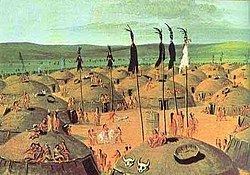NRHP Reference # 86002800 Nearest city Stanton | Added to NRHP 19 October 1986 | |
 | ||
Similar Fort Mandan, North Dakota Lewis an, Cross Ranch State Park, Fort Buford, Fort Abercrombie | ||
Fort Clark Trading Post State Historic Site was once the home to a Mandan and later an Arikara settlement. Over the course of its history it also had two factories (trading posts). Today only archeological remains survive at the site located eight miles west of Washburn, North Dakota, United States.
Contents
History
In 1822, the Mandan tribe built a settlement with earth-covered lodges on the bluffs of the Missouri River. In 1830, a representative of the American Fur Company built Fort Clark Trading Post south of the village. The first steamboat to journey up the upper-Missouri River was the Yellow Stone which arrived in 1832 carrying 1,500 gallons of goods and liquor. George Catlin, Karl Bodmer, and the German Prince Maximilian of Wied-Neuwied all visited the site and stayed the winter of 1832-1833. In 1837, the steamboat St. Peters docked at the village carrying passengers infected with smallpox, and sparking the 1837 Great Plains smallpox epidemic. As the disease swept through the village, it wiped out approximately ninety-percent of the inhabitants. In 1838, the nearby Arikara tribe moved into the abandoned village. In 1850, another trading post was built by Charles Primeau. In 1851, a cholera outbreak occurred and then a smallpox outbreak in 1856. When an attack by the Dakota happened in 1861, the fort was permanently abandoned.
Historic site
Most of the site has been owned by the state since 1889. A total of 125 acres (51 ha) in two sections of the state historic site were listed on the National Register of Historic Places in 1986 as Fort Clark Archeological District.
More than 2,200 features on the surface from the ruins of houses and graves still exist. Lodge depressions are also visible along with an unmarked cemetery with more than 800 graves. The site is operated by the North Dakota State Historical Society.
